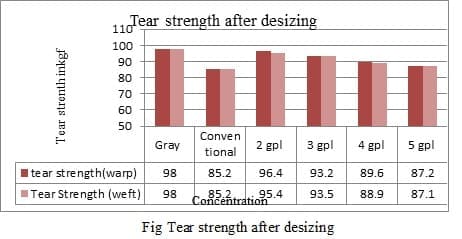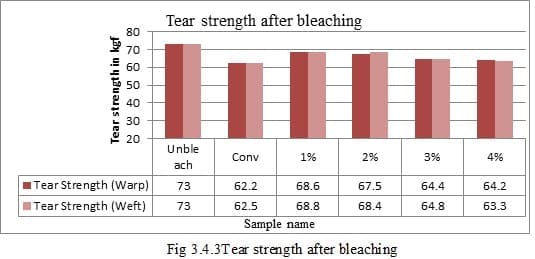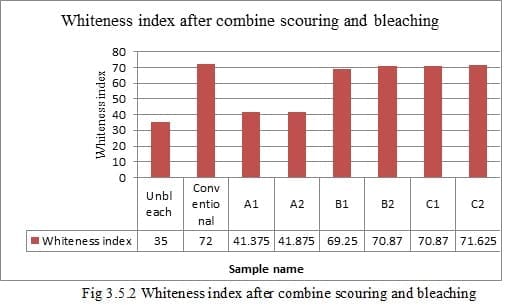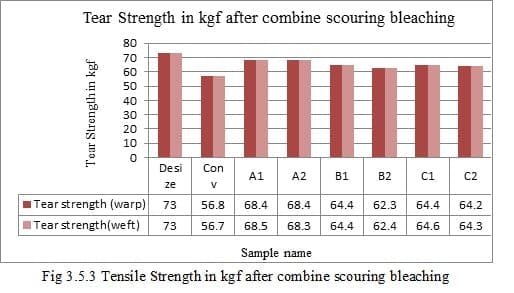Satish Y Patil, Yashovardhan M Indi
Department of textiles, DKTE’S Textile & Engineering Institute Ichalkaranji-416115
Correspondence e-mail: [email protected]
ABSTRACT: – Textile industry is the largest one next to agricultural in the country where most of the people are employed. Wet processing of cotton required high quantity of water and energy for desizing, scoring and bleaching process. Conventionally these processes are carried by using harsh chemical which is give water pollution. In order to control water pollution enzyme can be used of processing of cotton. At a same time enzyme required low temperature which is give energy conservation. This study is focused on comparative analysis between conventional desizing with enzyme desizing, alkaline scouring with bio scouring, conventional bleaching with bio bleaching and conventional combine scouring bleaching with bio combine scouring-bleaching. So advantages of bioprocessing can be described in terms of ecology as well as economy.
Keywords: – Enzyme, Conventional processing, Bio scouring, Bio bleaching.
Introduction
Cotton is the most important cellulose fibre in textile. But natural cotton fibre contains some impurities. Cotton fibre is highly hydroscopic also slightly coloured .In further processing cotton should absorb water to get satisfactory result. At a same time colour of cotton should be white before dyeing to achieve final required colour. Hence in order to get absorbency and whiteness scouring and bleaching process become important one. [1]
Traditionally scouring of cotton was carried out by using caustic soda and sodium carbonate. Both this chemical having high pH and increase load on ETP and because of higher concentration of alkali tenacity of cotton decrease. Bleaching of cotton also required high alkaline pH and high concentration of H2O2 reduces tenacity of cotton.
To reduce the water pollution in textile wet processing, we have to reduce the use of such high concentrate chemical. Also such chemical are available in market which does not affect the properties of cotton. One of the chemical which can be used in wet processing is enzyme. Use of enzyme in wet processing reduces the water pollution. Also required temperature is low as comparative to conventional processes hence use of energy is also low. Enzyme work on specific substrate it will not affect the properties of cotton and most important thing is there is less effluent generation. If bio-scouring and bio-bleaching could be combined into one process, large amounts of water, energy, time and auxiliary agents would be saved.
Enzyme desizing
Conventionally desizing is done by using hydrochloric acid or oxidizing agent. These chemicals reduce the strength of basic fabric by attack on starch as well as cellulose. Enzyme is the one option to avoid reduction in tensile strength of fabric. Fabric is padded through solution containing 1 gpl amylase and 0.5 gpl sodium chloride at 400C. For this process required pH is acidic (5.5). Fabric is padded by using padding mangle (100% expression) and batched for 24 hour at ambient temperature. The Desized fabric washed twice with hot water and once with cold water and then dried . Desizing by exhaust method is also possible where fabric is treated with 1gp amylases enzyme at 700C for 60 min with acidic pH.
Enzyme scouring
Cotton could not absorb water during processing within specific time (3 Sec) because of 0.4-1 % oil fat waxes in their structure. Removal of oil fat and waxes become so important to get satisfactory results in further processing. Conventionally scouring of cotton is done by using sodium hydroxide which is highly alkaline in nature. Along with impurities it break the bonds cellulose causes reduction in tensile strength. Use of highly alkaline chemical causes high COD (chemical oxygen demand), BOD (biological oxygen demand) and TDS in wastewater. Conventional scouring process is commonly used in industry but now-a-day it gives bad effect on environment. Conventional can be replaced by eco-friendly enzyme scouring process . Fabric is treated with pectinase 5 gpl enzyme at 550C in alkaline pH (8) for 60 min. this give satisfactory results and absorbency is depend on concentration of enzyme. Weight loss is less than the conventional scouring which means no strength loss in fabric. Enzymatic scouring of cotton fabric can be done by using various enzymes like cellulose, lipase, pectinase etc. Whiteness index obtained by the enzyme scouring is 8-10% more as compare to conventional scouring also no loss in tensile strength. Enzyme scouring give less BOD, COD, TDS as compare to conventional process. This method can be used for cotton as well as cotton blends by changing the enzyme . Alkaline pectinase enzyme can be combined with cellulose enzyme to get more absorbency. This process gives more absorbency but decrees the tensile strength of fabric .Advantages of enzyme scouring are less energy required, less water required, low cost of chemical, good absorbency, less strength loss, better dyeing effect. Lower effluent load soft feel same depth of colour. Also it can be combined with peroxide bleaching which reduce the cost of process.
Enzyme Bleaching
H2O2 is mostly used as bleaching agent in bleaching of natural, synthetic as well as blends of textile material. Mostly pH of H2O2 bleaching is 11.5 which is highly alkaline at a same time temperature required is also about 90oC . In order to save water and energy bleaching can be carried out by using glucose oxidase enzyme which is used as alone or can be combined with peroxidases also. H2O2 generated from glucose oxidases get combined with peroxidases which give better whiteness index as compare to conventional bleaching agent Desized and scoured fabric were bleached by using glucose oxidase enzyme. The whiteness index is 73% more than scoured fabric. Satisfactory degree of whiteness can be achieved by using glucose oxidase .
Enzyme combine scouring-bleaching
Use of ecofriendly chemical becomes so important because of increasing cost of water, energy and environmental aspect. Combined use of α-amylase and hemicellulose/pectinase in the pre-treatment of cotton gives combine desizing and scouring with better results than conventional and individual process. Glucose oxidase enzyme can be combine with other enzyme to get satisfactory result in bleaching .One bath bio scouring and bleaching of cotton give better results of absorbency, reduce load ETP and gives less degradation of cotton than alkali scouring and bleaching .Combine scouring and bleaching by using scouring enzyme and hydrogen peroxide give same effect that of individually process . Traditionally scouring and bleaching process carried out at the temperature 1200C in higher alkaline pH. It took lots of energy as well as water in further washing process of fabric which is converted in an effluent. In order to save energy and water higher alkaline chemical should be replace by ecofriendly chemical. Pectinase enzyme is an alternative to sodium hydroxide in scouring which give same result at low temperature. H2O2 can be replacing by using peroxidases, laccase /mediator or glucose oxidase. Bio-scouring and bio-bleaching can combine in one bath. Fabric is treated with scouring and bleaching enzyme at 650C for 60 min. Increase in temperature of this bath give better degree of whiteness. This process leads to less time, less energy, better results than conventional process .
- Material and Method
2.1.1 Material
100% cotton well singed fabric was taken for a study with particular are as below mentioned in table 2.1
Table 2.1: Fabric Particular
2.1.2 Chemical
A chemical were taken for study are mention with their particular in table 2.2
Table 2.2: Chemical used for study
2.2 Experimental method
2.2.1 Conventional desizing:-A well singed 100% cotton fabric was treated with 5 gpl hydrochloric acid at room temperature for 60 min followed by cold wash. The air dried fabric was check for absorbency, weight loss, tensile strength and tear strength.
2.2.2 Enzyme desizing:- A well singed 100% cotton fabric was treated with various concentration (2, 3, 4, 5 gpl) of enzyme. 10gpl common salt and 1 gpl wetting agent added in a bath. Treatment is carried out at 600C for 90 min. followed by cold wash. The air dried fabric was checked for absorbency, weight loss, tensile strength and tear strength
2.2.3 Alkaline scouring:- 100% cotton fabric was treated with 4% sodium hydroxide, 1.5% sodium bicarbonate, 0.1% detergent and 0.1% sequestering agent at 900C for 4 Hour followed by cold wash, hot wash and neutralization. The air dried fabric was checked for absorbency, tensile strength and tear strength
2.2.4 Enzyme scouring:- 100% cotton fabric was treated with 2, 3, 4, 5 % of pectinase enzyme at 500C for 2 Hour followed by cold wash and hot wash. The air dried fabric was checked for absorbency, tensile strength and tear strength.
2.2.5 Conventional bleaching: – 100% cotton fabric was treated 1% hydrogen peroxide, 1%stabiliser, 1% sodium carbonate, at 850C for 2 Hour followed by cold wash, hot wash and neutralization. The air dried fabric was checked for whiteness index, tensile strength and tear strength.
2.2.6 Enzyme bleaching: – 100% cotton fabric was treated with 1, 2, 3, 4 % of glucose oxidase enzyme at 800C for 2 Hour followed by wash and hot wash. The air dried fabric was checked for whiteness index, tensile strength and tear strength.
2.2.7 Conventional combine scouring bleaching: -100% cotton fabric was treated with1 % hydrogen peroxide, 2% sodium hydroxide, 2% stabilizer and 1% sodium carbonate at 850C for 2 hour followed cold by wash, hot wash and neutralization. The air dried fabric was checked for absorbency, whiteness index, tensile strength and tear strength.
2.2.8 Enzyme combine scouring and bleaching: – A 100% cotton fabric treated by three method as shown in table 2.2.8
Table 2.2.8: Recipe for enzyme combine scouring bleaching
2.2.9 Testing:- The various fabric physical and chemical properties are characterized as par standard testing method.
1. Weight loss (AATCC79)
2. Absorbency (AATCC TM 79)
3. Whiteness index (AATCC TM 110)
4. Tensile Strength (ASTM D 5035)
5. Tear strength (ASTM D 2261)
3. Result and Discussion
3.1 Introduction:-
Here conventional processed sample are compared with enzyme processed sample. The samples were tested for weight loss, absorbency tensile strength, and tear strength. The result were analyzed and discussed as below
3.2 Desizing: –
Weight loss after desizing is higher in conventional desizing as compared to enzymatic desizing as shown in fig 3.2.1. Enzyme desizing gives better desizing efficiency as compare to conventional method with less reduction in tensile and tear strength. With increase in concentration enzyme efficiency increases. 5 gpl enzyme give higher desizing efficiency which is confirm by TEGAWA test ( fig 3.2.2 & fig 3.2.3)
3.3 Scouring: – Absorbency of conventional scoured fabric is 1.89 second which is slightly low as compared to enzymatic scouring. As enzyme concentration increases absorbency time decreases in short range. The absorbency achieved by the enzymatic method at 5 gpl enzyme is near about same and also within acceptable limit as shown in fig 3.3.1. The loss in tensile strength and tear strength in conventional scouring sample is higher as compare to enzyme treated sample. This is because of degradation of cotton due to harsh chemical (fig 3.3.2& Fig 3.3.3)
3.4 Bleaching: – Whiteness index of conventional fabric is more as compare than the enzyme bleached sample. As concentration of glucose oxidase increases the whiteness index is also increases but still it is less than the conventional bleaching as shown in fig 3.4.1. The tensile and tear strength of conventional bleaching and enzyme bleaching is near about same. There is no any significant difference in tensile and tear strength between conventional bleaching and enzymatic bleaching.( fig 3.4.2 and 3.4.3)
3.5 Combine scouring bleaching:- Absorbency time for conventional sample and all enzyme methods sample are near about same. At a same time as concentration increases absorbency time decreases. All enzyme method gives same absorbency as compare to conventional method as shown in fig 3.5.1. The whiteness index for conventional method is neat about 70. Whiteness index in method A for concentration A1 is 41.37 and A2 is 41.87 respectively. This whiteness index is too less and there is no increase in whiteness index in method A. In method B and method C whiteness index increases up to conventional method. Hence pectinase enzyme can be combine with hydrogen peroxide as well as addition of hydrogen peroxide in enzyme bath give same whiteness as conventional method as shown in fig 3.5.2. Tensile and tear strength in conventional method is less as compare to all enzyme method. This is because of breaking of hydrogen bonds in cellulosic structure due to use of concentrate chemical. Tensile and tear strength in method A remains same for both concentrations indicate there is no any effect of enzyme concentration on tensile strength. In method B and C as concentration of hydrogen peroxide increases tensile strength decreases slightly but still it is within acceptable limit as compare to conventional method .(fig 3.5.3 and 3.5.4)
CONCLUSION:-
Conventional desizing, scouring, bleaching, and combine scouring bleaching process con be converted to enzymatic process with same result of weight loss, absorbency, tensile strength and tear strength. Here enzyme is ecofriendly in nature hence water pollution can be reduced. In bio scouring temperature required is low as compared to conventional method, 50% of energy can be saved.
REFERANCE
- S. P. Mishra,Cotton “A Text Book of Fibre Science and Technology” Page 71-87
- Mahesh sharma “Application of enzyme in textile processing” Colourage, January 1993
- Ali Hebeish , Mohamed Hashem , Nihal Shaker, Mohamed Ramadan, Bahiya El-Sadek,Marwa Abdel Hady “New development for combined bioscouring and bleaching of cotton-based fabrics” Elsevire Carbohydrate Polymers 78 (2009) 961–972
- Tzanko Tzanov, Margarita Calafellb, Georg M. Guebitzc, Artur Cavaco-Pauloa, “Bio Processing of Cotton Fabric” Journal of Enzyme and Microbial Technology 29 (2001) 357-362
- N. Mahapatra “Use of enzyme in textile processing” Asian Dyer, july 2010, 53
- Azizul Hoque, Abu Yousuf Mohamamd Anwarul Azim “Using Enzymes as an Aid of Better and Eco-Friendly Scouring Processing” American Journal of Engineering Research, Volume-5, Issue-6, 167-182
- S. K. Laga, Miss. Geeta K. Chunari “Bioscouring: An overview” Colourage, April 2015,39
- A Edvin Sunder, G nalankilli “Bio-scouring” Asin Textile Journal, January 2002
- K. Patra, Gaurav Agrawal, Sumit Garg “ Enzymatic scouring & bleaching compatibility of cotton” The Indian Textile Journal, April 2004/25
- Sonia Hossain, Md. oushic Uddin “comparative analysis between conventional pretreatmentK and bioprocessing” International Journal of Engineering & Technology vol:11 no:3
- Klaus Opwis, Dierk Knitte, Eckhard Schollmeyer “Use of enzyme in pretreatment of cotton” Deutsches Textilforschungszentrum Nord-West e.V. Adlerstr. 1, D-47798 Krefeld, Germany
- Geeta N. sheth, Aparna A. Musale “Single bath bio-scouring and bleaching of cellulosic yarn knitted and woven fabric”, Colourage nov 2015
- Nina Spicka and Petra Forte Tavcer “New Combined Bio Scouring and Bio Bleaching Process Of Cotton Fabric ” Material and Technology 47 (2013) 4, 409-412

















